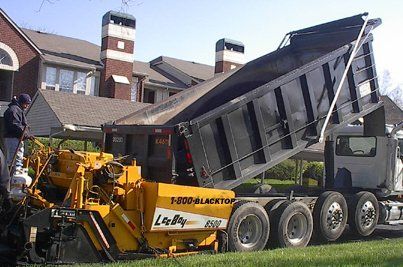Call us: 1-800-BLACKTOP
Asphalt Paving

Asphalt Paving Contractor Services
At Performance Asphalt Paving, we don't believe in resting on the laurels of our past accomplishments. Our current success is based on our reputation as qualified experts in our field. We plan to continue building upon reputation for years to come. We have a very experienced asphalt paving crew that shares decades of work experience. We have late model, high quality equipment that helps provide high quality work.

Asphalt Paving
We are always courteous and respectful toward our customers. We work hard to ensure that you will think of us the next time your friends or family require the services we provide.
We offer the following:
COMMERCIAL PAVING - RESIDENTIAL PAVING
Asphalt Paving · Seal Coating · Concrete ·
Residential
- Driveway Paving
- Driveway Repair
- Driveway Sealing
- Patios/Walkways
Commercial
- Overlays
- Patchwork
- Apartments
- Commercial Asphalt Paving
- Asphalt Repair
Industrial
- Churches
- Shopping Centers
- Factories
- New Construction
Municipal
- Roads
- Subdivisions
- Striping
- Alleys
- Street Rehabilitation
Common Asphalt Problems
Graying and Raveling
Progressive fading of a black asphalt surface to shades of gray is evidence of oxidation caused by solar ultraviolet radiation. As this damage progresses, the binder shrinks and pulls away from the aggregate. Eventually, the aggregate begins to protrude from the surface and separate from the pavement. This condition is termed "raveling."
Last Seal Coated When?
Seal coat is sun block for your pavement. Applications at three-year intervals will virtually stop solar damage to the binder material. For that reason, seal coating is a very cost-effective preventative maintenance measure. It greatly extends the useful life of pavement. Seal coat is a latex-based coal tar pitch emulsion fortified with latex rubber additives and sand. It resists damage from solar radiation, petroleum spills, and water penetration.
Simple Cracks
In time, most parking areas will show some simple cracks. These may be caused by aging and shrinkage of the binder, or by some movement or migration of the pavement. Cracks of this type are not a serious problem, if they are corrected in a timely fashion. The cracks should first be cleaned with pressurized air, and then sealed using hot-applied rubberized joint sealant. This will prevent further damage from water penetration and winter freeze-thaw cycles.
Spider-Web Cracks and Potholes
Areas of closely spaced, interconnecting cracks occur most often where simple linear cracks have been neglected and not properly sealed. Water then penetrates to the base soil, which yields under the weight of passing traffic. Eventually, the pavement breaks through completely, forming potholes.
Spider-web cracks can also be a symptom of insufficient pavement thickness, inadequate base preparation, or poor drainage. For that reason, it is important to involve a knowledgeable pavement specialist in evaluating the problem when spider-web cracking is first noted.
If the damage is caught early enough, repairs can be made with the cut and patch paving method. The defective area is cut square beyond damage, ripped out, re-graded, and repaved with basecoat binder and bituminous asphalt topcoat. Edges of the patched pavement are emulsified to bond the new asphalt to the old.
If extensive, cut and patch work is needed to reclaim the parking lot, then complete repaving, followed by the implementation of a preventative maintenance program. This process is the most cost-effective solution.
Ask for Free Pavement Analysis
Obtaining the best return for your pavement maintenance dollar is not a simple decision or process. A knowledgeable pavement contractor can evaluate the condition of your parking areas, design a cost-effective maintenance program, and estimate reliable dollar information for your budget.

